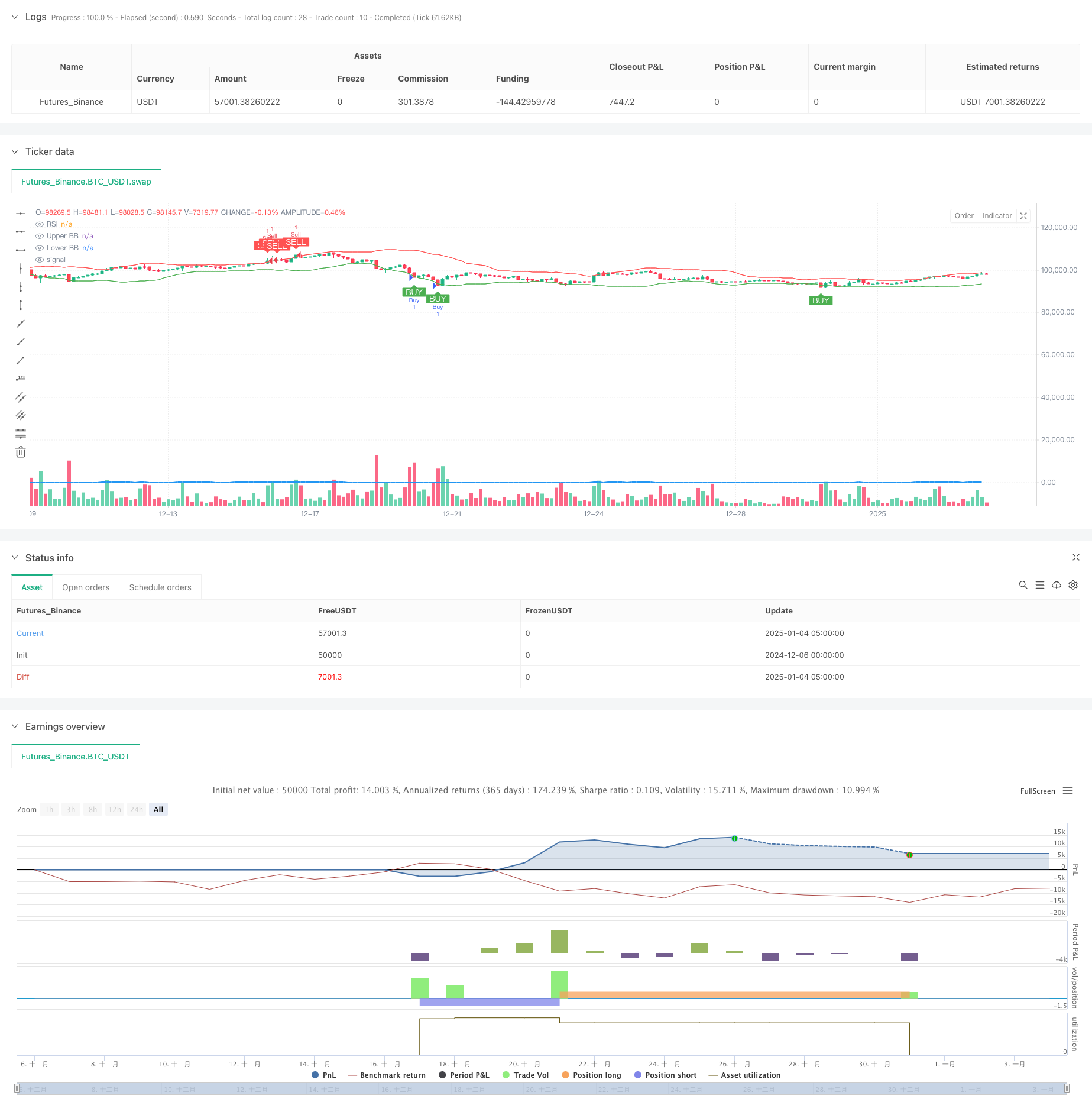
概述
该策略是一个结合RSI和布林带双重技术指标的动量反转交易系统,通过识别超买超卖区域进行交易。策略采用了1:2的风险收益比,并结合了移动止损来进行风险控制。核心逻辑是在RSI和布林带同时出现超买或超卖信号时进行交易,通过严格的风险管理来保护资金。
策略原理
策略使用14周期RSI和20周期布林带作为主要指标。买入条件需同时满足:RSI低于30(超卖)且价格触及或低于布林带下轨。卖出条件需同时满足:RSI高于70(超买)且价格触及或高于布林带上轨。系统采用5根K线的最高/最低点作为移动止损,止盈位置为止损距离的2倍,严格执行1:2的风险收益比。
策略优势
- 双重技术指标过滤提高了信号质量,减少虚假信号
- 结合动量和波动率指标,提供更全面的市场视角
- 严格的风险控制机制,包括移动止损和固定风险收益比
- 系统完全自动化,消除人为情绪干扰
- 策略逻辑清晰,易于理解和维护
策略风险
- 在趋势市场中可能频繁止损
- 双重条件可能错过部分交易机会
- 固定的RSI和布林带参数可能不适用所有市场环境
- 移动止损可能在波动市场中过早退出
- 需要合理的资金管理以应对连续亏损
策略优化方向
- 引入自适应参数机制,根据市场波动度动态调整指标参数
- 增加趋势过滤器,在强趋势中暂停反转交易
- 开发动态风险收益比系统,根据市场状况调整
- 加入成交量确认机制,提高信号可靠性
- 实现更灵活的止损机制,如跟踪止损或时间止损
总结
这是一个结构完整的反转交易策略,通过双重技术指标提高准确性,并采用严格的风险管理。策略虽然简单直观,但包含了成熟的交易系统所需的关键要素。通过建议的优化方向,该策略还有进一步提升的空间。在实盘交易中,建议先进行充分的回测和参数优化。
策略源码
/*backtest
start: 2024-12-06 00:00:00
end: 2025-01-04 08:00:00
period: 3h
basePeriod: 3h
exchanges: [{"eid":"Futures_Binance","currency":"BTC_USDT"}]
*/
//@version=5
strategy("RSI + Bollinger Bands with 1:2 Risk/Reward", overlay=true)
// Define Inputs
length_rsi = input.int(14, title="RSI Period")
oversold_level = input.int(30, title="RSI Oversold Level")
overbought_level = input.int(70, title="RSI Overbought Level")
length_bb = input.int(20, title="Bollinger Bands Period")
src = close
risk_to_reward = input.float(2.0, title="Risk-to-Reward Ratio", minval=1.0, step=0.1)
// Calculate Indicators
rsi_value = ta.rsi(src, length_rsi)
basis = ta.sma(src, length_bb)
dev = ta.stdev(src, length_bb)
upper_band = basis + 2 * dev
lower_band = basis - 2 * dev
// Define Buy and Sell Conditions
rsi_buy_condition = rsi_value < oversold_level // RSI below 30 (buy signal)
bollinger_buy_condition = close <= lower_band // Price at or near lower Bollinger Band (buy signal)
rsi_sell_condition = rsi_value > overbought_level // RSI above 70 (sell signal)
bollinger_sell_condition = close >= upper_band // Price at or near upper Bollinger Band (sell signal)
// Combine Buy and Sell Conditions
buy_condition = rsi_buy_condition and bollinger_buy_condition
sell_condition = rsi_sell_condition and bollinger_sell_condition
// Plot Buy and Sell Signals with white text and green/red boxes
plotshape(series=buy_condition, location=location.belowbar, color=color.green, style=shape.labelup, title="Buy Signal", text="BUY", textcolor=color.white, size=size.small)
plotshape(series=sell_condition, location=location.abovebar, color=color.red, style=shape.labeldown, title="Sell Signal", text="SELL", textcolor=color.white, size=size.small)
// Calculate Swing Points (for Stop Loss)
swing_low = ta.lowest(low, 5) // Last 5 bars' low
swing_high = ta.highest(high, 5) // Last 5 bars' high
// Calculate Risk (Distance from Entry to SL)
long_risk = close - swing_low
short_risk = swing_high - close
// Calculate Take Profit using 1:2 Risk-to-Reward Ratio
take_profit_long = close + 2 * long_risk
take_profit_short = close - 2 * short_risk
// Strategy Execution: Enter Buy/Sell Positions
if buy_condition
strategy.entry("Buy", strategy.long)
strategy.exit("Take Profit", "Buy", limit=take_profit_long, stop=swing_low) // Set TP and SL for Buy
if sell_condition
strategy.entry("Sell", strategy.short)
strategy.exit("Take Profit", "Sell", limit=take_profit_short, stop=swing_high) // Set TP and SL for Sell
// Plotting the Indicators for Visualization (Optional - comment out if not needed)
plot(rsi_value, color=color.blue, title="RSI", linewidth=2, display=display.none)
plot(upper_band, color=color.red, title="Upper BB", display=display.none)
plot(lower_band, color=color.green, title="Lower BB", display=display.none)
相关推荐